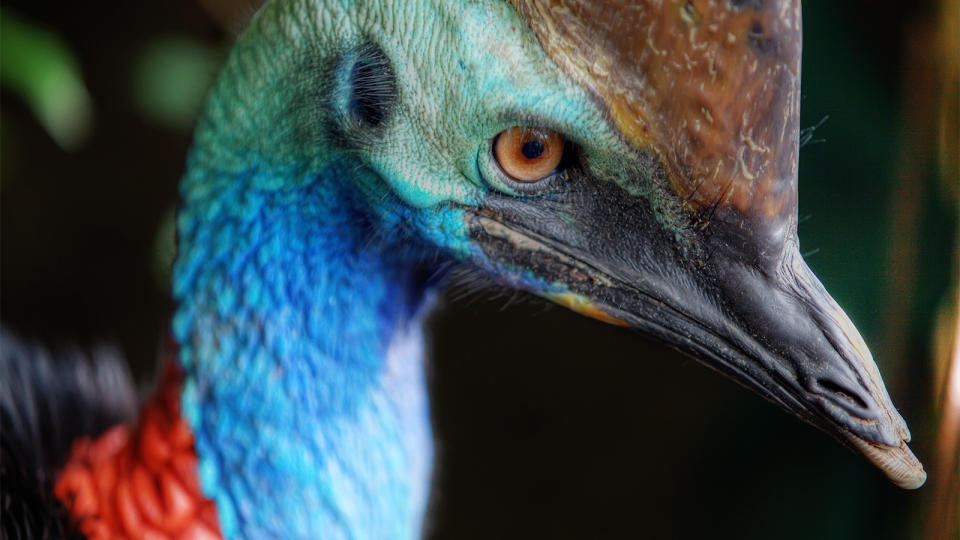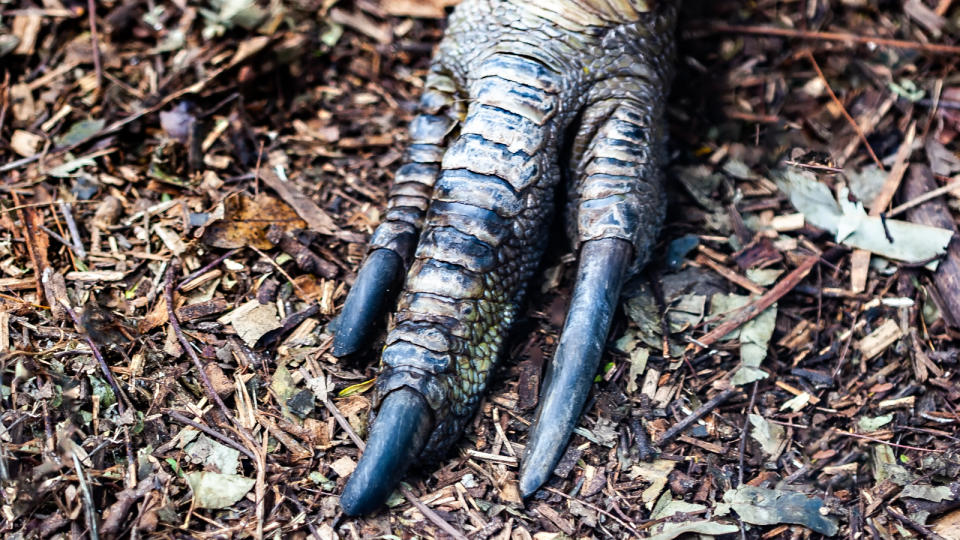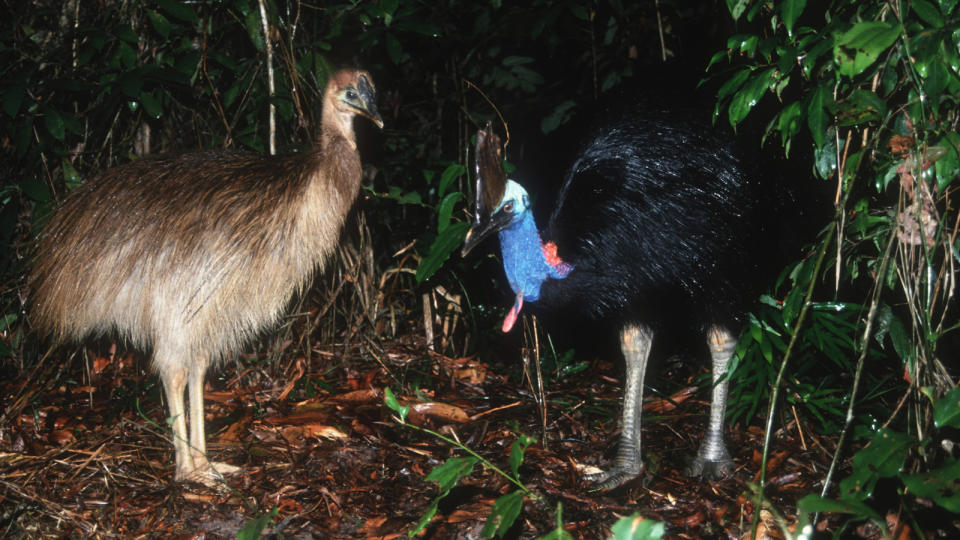The Cassowary Is the World's Most Dangerous Bird

People have referred to the cassowary — a massive, flightless, emu-like creature — as the most dangerous bird in the world, owing to the fact it can seriously injure or kill a human or dog in an instant with its deadly claws. But what exactly is a cassowary, and what makes this exotic bird so threatening?
What Is a Cassowary?
Cassowaries are ratites, or birds that have flat breastbones and are unable to fly, just like their cousin, the emu. The cassowary habitat extends from the dense rainforests of northeastern Australia to New Guinea and the surrounding islands.
Size varies from one cassowary species to another. The most common cassowaries, the southern cassowaries, can be 5 to 6 feet (1.5 to 1.8 meters) tall and weigh nearly 170 pounds (77 kilograms). A dwarf cassowary bird, on the other hand, may be only 3 feet (1 meter) tall and around 60 pounds (27 kilograms).
"Cassowaries are the heaviest bird in Australia, and the southern cassowary is the second-heaviest in the world (the world's heaviest bird is the ostrich)," says Rick Schwartz, a global ambassador for California's San Diego Zoo, which currently houses several southern cassowaries in its Safari Park, in an email interview. "With that in mind, they also have very small wings. When stretched out, their wings extend less than a foot (0.3 meters) from their body."

What Does a Cassowary Look Like?
There are three different species of cassowaries: the northern cassowary, southern cassowary and dwarf cassowary. The southern cassowary, often found in Northern Queensland and New Guinea, is known for its striking appearance, with bristly feathers, a vivid blue face, two red wattles and a prominent helmet, or casque.
"Of the three species of cassowaries, only the northern and southern cassowaries have wattles," Schwartz says. "It is thought that they can help communicate the bird's current demeanor, indicate an individual bird's vitality to other cassowaries or give other cues and communications only known by cassowaries at this time."
The bird's casque is made of keratin, the same protein that the bird's feathers, nails and beak are made of, according to Schwartz. "The outer covering is thick and hard," he says, "but the inside is very porous."
Schwartz continues, "The purpose of the casque is not completely understood, but several theories exist — including that it can help amplify vocalizations, serve as head protection as the bird pushes headfirst through the dense forest, or it may be another way for the birds to display age and vitality."
The Cassowary Diet
Cassowaries are frugivores, meaning they feed on fruits. Their claws help them dig deep in the leaf litter for fallen fruit that other species might miss. This makes them very important to their surrounding ecosystem, according to Schwartz.
The seeds of any fruit the bird eats are passed through the cassowary's digestive tract as it walks around, he explains. "Thus, their droppings deposit seeds that are surrounded in natural fertilizer, helping to spread the diversity of plants in their region."
Due to the important role they play in spreading these fruit seeds far and wide, researchers consider cassowaries to be a keystone species. Due to their large size, they are able to spread larger seeds than most birds can, such as those of the Ryparosa, a rare Australian rainforest tree.

The Cassowary Family Unit
Male cassowaries play a more prominent role than female cassowaries do in rearing their young. After the female lays her eggs, the male participates in incubation and then is the primary caretaker for the young cassowary chicks after they hatch.
"The female returns to her solitary life," Schwartz says, "and does not participate in incubating the eggs or caring for the young. This may be a way to allow her to have several clutches of eggs in one breeding season with different males, thus diversifying her genetics into the next generation."
Cassowaries vs. Emus
While a cassowary is not an emu, both emus and cassowaries can be considered related in taxonomy (the science of animal classification for living and extinct species), said Schwartz. "They share the same scientific order [Casuariiformes]," he explains. "But, within that order, they are in different scientific families."
Cassowaries Are Descended From Dinosaurs
Cassowaries are direct descendants of the dinosaurs. As noted by Rainforest Rescue's Save the Cassowary campaign, modern birds descended from dinosaurs, and cassowaries belong to one of the most ancient lineages of living birds.
The casque of the cassowary may serve a similar function to that of the helmet of the lambeosaurus (a duck-billed dinosaur). Similarities in their feet and respiratory systems also exist between cassowaries and theropod dinosaurs. Finally, their breeding behavior also shares commonalities with some groups of dinosaurs.
Why Can't Cassowaries Fly?
Cassowaries' feathers aren't suitable for flying. A cassowary has dense, black feathers that are long and thin compared with the wide and shapely feathers of a flighted bird, according to Schwartz. "From a distance, some people even say the feathers of the cassowary look more like hair," he adds.
"The cassowary's feathers are not suitable for flight, but they work very well for a ground-dwelling bird living in a forest ecosystem," he continues. "The longer, thinner feathers help direct water away from the body and also protect the bird's body from low branches, sharp twigs and thorns."
What Makes a Cassowary Such a Dangerous Bird?
Cassowaries' speed and physical characteristics make them serious threats. Thanks to their powerful legs, cassowaries can run at about 31 miles per hour (50 km/h), even through dense forest underbrush. These muscular legs end in claw-tipped toes that can pack a pretty powerful punch, including severe bleeding and lethal wounds to a victim's internal organs.

"The claw on the inner toe of each foot is what is so impressive," Schwartz says. "Between the three species, that claw is very sharp and can range from 3 to 5 inches (7 to 12 centimeters) long. The cassowary will use these sharp claws and their powerful kick to defend themselves. It is often stated that they can eviscerate a human in a single kick, though there is no record of this happening."
Do Cassowaries Attack People?
Cassowaries do attack people on occasion and are even capable of killing a human. In 2019, a cassowary killed a 75-year-old Florida man who was raising the bird on his property. After he tripped and fell, the bird attacked him, and he later succumbed to his injuries at the hospital.
In Florida, where the man died, the state lists cassowaries (along with alligators and wild cats) as Class II animals due to the risk they pose. This means anyone who wishes to own one must pass numerous tests and get a special permit from local authorities. Even then, cassowary attacks can obviously still occur, due to how unpredictable the bird can be.
Fortunately, attacks like this are uncommon. According to Guinness World Records, you're far more likely to suffer a snake bite or even an infection transmitted by a dog than you are an injury by a cassowary.
Additionally, cassowaries are far from being the deadliest animal on the planet. That title goes to mosquitoes, which are responsible for between 725,000 and 1 million human deaths per year through the transmission of disease-causing pathogens.
To avoid a cassowary attack, don't provoke the bird. Better yet, steer clear of it entirely.

Where to See a Cassowary
The best place to see a cassowary is at a zoo or other animal park. This is not only for your safety but also because it's very rare to come across a cassowary in its natural habitat.
Dense rainforest flora would make it difficult to spot a cassowary, even with its brightly colored head. Also, you're unlikely to hear one, as its bird call is right at the edge of human hearing.
"It's the lowest known call of any bird," Schwartz says of the deep, low-frequency booming sound. "And it's so low that it borders on being inaudible to the human ear. If you are nearby when it does this call, you can feel the vibrations in your chest."
According to Schwartz, cassowaries are good at avoiding people.
"With their excellent hearing, they will hear you coming long before you even know they are there, and they will most likely disappear into the forest to avoid you," he says. "However, should you ever come across one in the wild, it is best to give them plenty of room and not approach them or try to feed them."
The Cassowary Population Is Dwindling
Per the International Union for Conservation of Nature (IUCN) Red List of Threatened Species (the world's most comprehensive inventory of the global conservation status of plant and animal species), all three species of cassowary are listed as Least Concern — but the populations are decreasing.
"Like many species, their biggest challenges are the loss of habitat due human population growth; roads being built (causing car strikes); and human-introduced species of animals raiding nests," Schwartz says. "The good news is that the governments of the countries cassowaries call home are stepping up their conservation efforts."
Dogs are another big threat to young cassowaries, as is hunting. Poachers capture young birds and sell them for their meat and stunning feathers.
According to Rainforest Rescue, there are fewer than 4,600 cassowaries left in the wild. (Thankfully, that's up from 2021's number, which was less than 1,000!)
The dwarf cassowary, also known as Bennett's cassowary, in New Guinea is the most threatened. An Australia-based organization, Rainforest Rescue is working to protect and restore the bird's natural habitat, as well as to create safe passage for these and other creatures via the strategic buy-back of rainforest properties and regeneration of damaged rainforest.
Original article: The Cassowary Is the World's Most Dangerous Bird
Copyright © 2024 HowStuffWorks, a division of InfoSpace Holdings, LLC, a System1 Company


